You searched for: 数字货币游戏,加密货币游戏,数字币游戏,used博彩游戏,【www.2266.com,复制打开网址】,ust泰达币博彩网站,区块链游戏排名,区块链游戏nft,区块链游戏平台,nft游戏有哪些,nft是什么游戏,以太坊游戏,区块链游戏赚钱网站,币圈游戏,区块链博彩平台,网址kaefhfkccdckbghcd
<< Previous | Displaying results 201-250 of 1782 for "数字货币游戏,加密货币游戏,数字币游戏,used博彩游戏,【www.2266.com,复制打开网址】,ust泰达币博彩网站,区块链游戏排名,区块链游戏nft,区块链游戏平台,nft游戏有哪些,nft是什么游戏,以太坊游戏,区块链游戏赚钱网站,币圈游戏,区块链博彩平台,网址kaefhfkccdckbghcd" | Next >>
-
The 8th Infantry Division during World War II
ArticleThe 8th Infantry Division participated in major WWII campaigns and is recognized for liberating the Wöbbelin subcamp of Neuengamme in 1945.
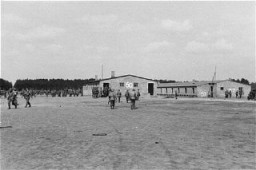
-
The 63rd Infantry Division during World War II
ArticleThe 63rd Infantry Division participated in major WWII campaigns and is recognized for liberating several of the Kaufering subcamps of Dachau in 1945.
-
The 80th Infantry Division during World War II
ArticleThe 80th Infantry Division participated in major WWII campaigns and is recognized for liberating Buchenwald and the Ebensee subcamp of Mauthausen in 1945.
-
The 84th Infantry Division during World War II
ArticleThe 84th Infantry Division participated in major WWII campaigns and is recognized for liberating two Neuengamme subcamps, Hannover-Ahlem and Salzwedel, in 1945.
-
The 90th Infantry Division during World War II
ArticleThe 90th Infantry Division participated in major WWII campaigns and is recognized for liberating the Flossenbürg concentration camp in 1945.
-
The 30th Infantry Division during World War II
ArticleThe 30th Infantry Division participated in major WWII campaigns and is recognized for liberating the Weferlingen subcamp of Buchenwald in 1945.
-
An emaciated Soviet prisoner of war soon after liberation
PhotoSoon after liberation, a US Army doctor examines an emaciated forced laborer, a Soviet prisoner of war. Dortmund, Germany, April 30, 1945.
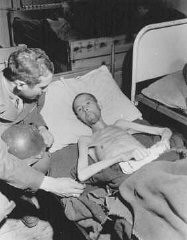
-
Documenting Liberation: J Malan Heslop
ArticleLearn about J Malan Heslop, one of the first Allied photographers in the Army Signal Corps to document evidence of Nazi crimes.
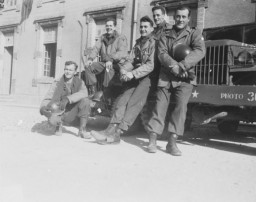
-
The 4th Infantry Division during World War II
ArticleThe 4th Infantry Division participated in major WWII campaigns and is recognized for liberating the Haunstetten subcamp of Dachau.
-
The United States Army Signal Corps
ArticleThe US Army Signal Corps had a crucial role in documenting—in both film and photographs—the atrocities perpetrated during the Holocaust.
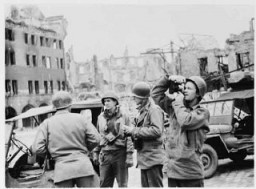
-
The 102nd Infantry Division
ArticleOn April 14, 1945, the US 102nd Infantry Division uncovered the site of a hideous massacre of concentration camp prisoners outside the town of Gardelegen.
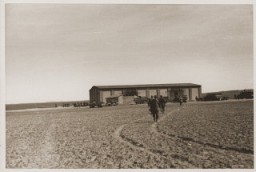
-
Deadly Medicine: Irmgard Huber
ArticleIrmgard Huber was head nurse of the facility at Hadamar, one of 6 major "euthanasia" killing centers in Nazi Germany. Learn more about her role.
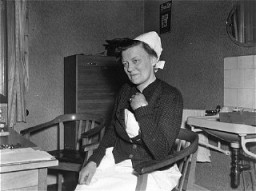
-
Ritchie Boys
Article“Ritchie Boys” is a term used for American soldiers who trained at Camp Ritchie during World War II. Several thousand were Jewish refugees from Europe. Learn more.
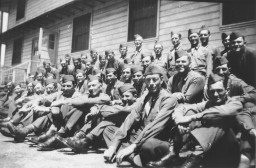
-
A soldier greets liberated prisoners
PhotoA US soldier with liberated prisoners of the Mauthausen concentration camp. Austria, May 1945.
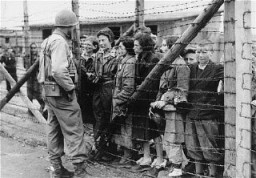
-
Eisenhower tours a newly liberated concentration camp
PhotoUS General Dwight D. Eisenhower and General Troy Middleton, commanding general of the XVIII Corps, Third US Army, tour the newly liberated Ohrdruf concentration camp. Ohrdruf, Germany, April 12, 1945.
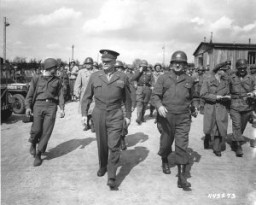
-
An African-American soldier with the 12th Armored Division
PhotoAn African-American soldier with the 12th Armored Division, Seventh U.S. Army, stands guard ov...
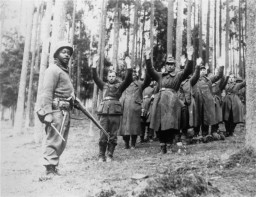
-
French Liberation
FilmJubilation over the liberation of Paris: US troops parade along the Champs-Elysees and French civilians celebrate. General Charles de Gaulle and General Omar Bradley review the troops.
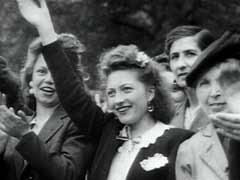
-
German civilians are forced to view a wagon piled with corpses
PhotoGerman civilians under US military escort are forced to view a wagon piled with corpses in the newly liberated Buchenwald concentration camp. Buchenwald, Germany, April 16, 1945.
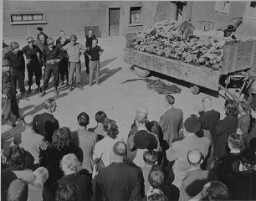
-
Insignia of the 11th Armored Division
PhotoInsignia of the 11th Armored Division. "Thunderbolt" is a nickname adopted by the 11th Armored Division during its rapid march in December 1944 to reinforce US troops defending against the German military offensive in the Ardennes Forest.
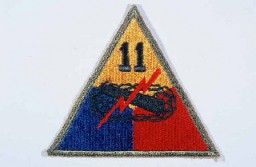
-
Insignia of the 20th Armored Division
PhotoInsignia of the 20th Armored Division. Although no nickname is commonly associated with the 20th, "Armoraiders" may have been occasionally in use during World War II.
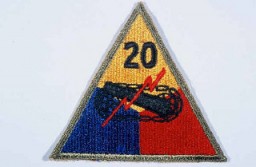
-
Bodies of prisoners discovered in Wöbbelin
PhotoA US Army soldier views the bodies of prisoners piled on top of one another in the doorway of a barracks in Wöbbelin. Germany, May 4–5, 1945.
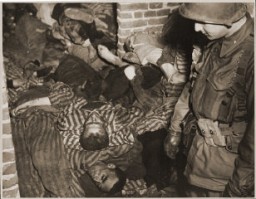
-
Insignia of the 65th Infantry Division
PhotoInsignia of the 65th Infantry Division. The 65th Infantry Division was nicknamed the "Battle Axe" after the divisional insignia, a halbert (an axe on a pole), used to cut through the enemy during medieval times.
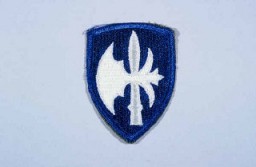
-
Arnold E. Samuelson.
PhotoPortrait of US combat photographer Arnold E. Samuelson. France, 1944-1945. Samuelson took some of the best known photographs of Holocaust survivors upon the liberation of the camps.
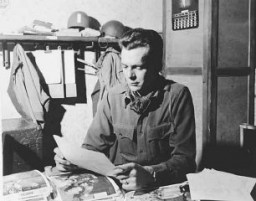
-
Insignia of the 4th Armored Division
PhotoInsignia of the 4th Armored Division. The commanding general of the 4th Armored Division refused to sanction an official nickname for the 4th, believing that the division's accomplishments on the battlefield made one unnecessary. "Breakthrough" was occasionally used, apparently to highlight the division's prominent role in the breakout from the Normandy beachhead and liberation of France in 1944.
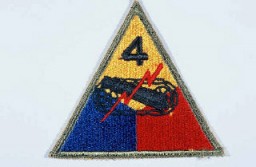
-
Survivors in Buchenwald just after liberation
PhotoSurvivors in Buchenwald just after liberation. Troops of the US 6th Armored Division entered Buchenwald on April 11, and troops of the 80th Infantry arrived on April 12. Buchenwald, Germany, photograph taken ca. April 11, 1945.

-
Insignia of the 86th Infantry Division
PhotoInsignia of the 86th Infantry Division. The 86th Infantry Division developed the blackhawk as its insignia during World War I, to honor the Native American warrior of that name who fought the US Army in Illinois and Wisconsin during the early nineteenth century. The nickname "The Blackhawks" or "Blackhawk" division is derived from the insignia.
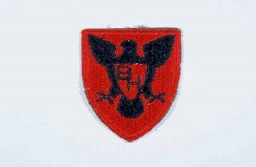
-
Insignia of the 9th Armored Division
PhotoInsignia of the 9th Armored Division. Although no nickname for the 9th was in common usage throughout World War II, "Phantom" division was sometimes used in 1945. It originated during the Battle of the Bulge, when the 9th Armored Division seemed, like a phantom, to be everywhere along the front.
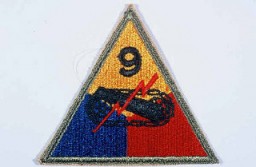
-
Insignia of the 45th Infantry Division
PhotoInsignia of the 45th Infantry Division. The 45th Infantry Division gained its nickname, "Thunderbird" division, from the gold thunderbird. This Native American symbol became the division's insignia in 1939. It replaced another previously used Native American symbol, a swastika, that was withdrawn when it became closely associated with the Nazi Party.
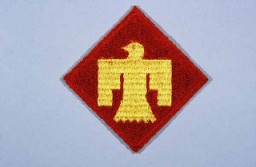
-
Dachau trial mess card
ArtifactEntry pass to a US military dining hall at Dachau, Germany. This card was issued to Anton Litwin, a member of the War Crimes Branch.
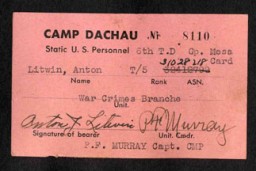
-
Eisenhower views corpses
PhotoGeneral Dwight D. Eisenhower (center, right) views the corpses of victims of the Ohrdruf camp. Germany, April 12, 1945.
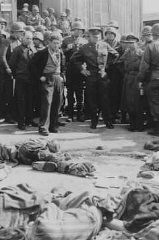
-
Victims of the Gardelegen atrocity
PhotoAmerican soldiers look at the exhumed bodies of prisoners who were burned alive in a barn outside Gardelegen. Germany, April 14-18, 1945.
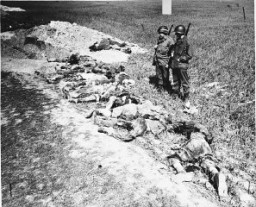
-
Survivors of the Buchenwald camp
PhotoSurvivors of the Buchenwald concentration camp gather around trucks carrying American troops. Germany, May 1945.

-
Eisenhower views burned remains of inmates
PhotoGeneral Dwight D. Eisenhower (third from left) views the charred remains of inmates of the Ohrdruf camp. Ohrdruf, Germany, April 12, 1945.
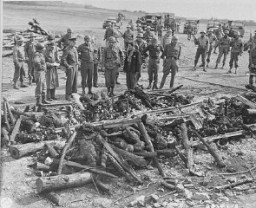
-
Insignia of the 2nd Infantry Division
PhotoInsignia of the 2nd Infantry Division. The nickname of the 2nd Infantry Division, "Indianhead," was derived from its World War I insignia. This insignia was developed from an emblem a truck driver in the division had painted on his truck.
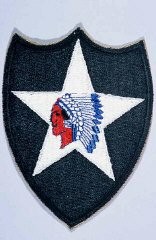
-
Insignia of the 4th Infantry Division
PhotoInsignia of the 4th Infantry Division. The 4th Infantry Division's nickname, the "Ivy" division, is derived from the divisional insignia developed during World War I: four ivy leaves on a diamond field, symbolizing the roman numeral "IV."
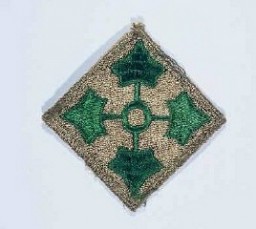
-
Insignia of the 6th Armored Division
PhotoInsignia of the 6th Armored Division. "Super Sixth" became the nickname of the 6th Armored Division while the division was training in the United States, apparently to symbolize the division's spirit.
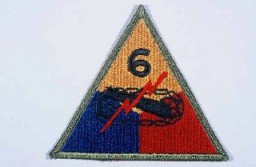
-
Insignia of the 26th Infantry Division
PhotoInsignia of the 26th Infantry Division. The 26th Infantry Division, the "Yankee" division, was so nicknamed to recognize the six New England states from whose National Guard units the division was raised during World War I.
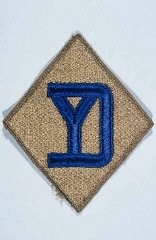
-
Insignia of the 10th Armored Division
PhotoInsignia of the 10th Armored Division. The "Tiger Division" nickname of the 10th originates from a division-wide contest held while it was training in the United States, symbolizing the division "clawing and mauling" its way through the enemy.
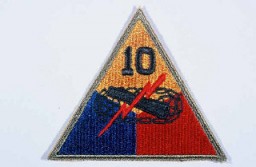
-
View of the Wöbbelin concentration camp
PhotoOn May 2, 1945, the 8th Infantry Division and the 82nd Airborne Division encountered the Wöbbelin concentration camp. Here, American soldiers patrol the perimeter of the camp. Germany, May 4-May 10, 1945.
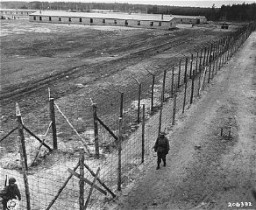
-
Insignia of the 104th Infantry Division
PhotoInsignia of the 104th Infantry Division. The nickname of the 104th Infantry Division, "Timberwolf," originated from the division's insignia, a gray timberwolf. The timberwolf, native to the Pacific Northwest, was chosen as representative of the area where the division was formed in 1942.
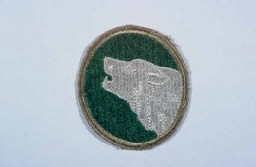
-
Aftermath of the Gardelegen atrocity
PhotoAn American tank follows German civilians from Gardelegen who are marching to a barn just outside the town, where they will dig graves for over 1,000 prisoners killed by the SS inside the barn. April 18, 1945.
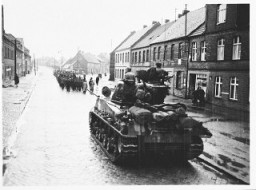
-
Insignia of the 3rd Armored Division
PhotoInsignia of the 3rd Armored Division. "Spearhead" was adopted as the nickname of the 3rd Armored Division in recognition of the division's role as the "spearhead" of many attacks during the liberation of France in 1944.

-
Insignia of the 69th Infantry Division
PhotoInsignia of the 69th Infantry Division. The 69th Infantry Division gained the nickname the "Fighting 69th" during World War II. The name has no heraldic significance, but simply conveys the esprit de corps of the division.
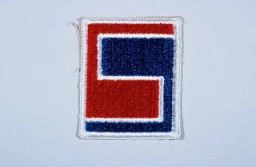
-
Insignia of the 71st Infantry Division
PhotoInsignia of the 71st Infantry Division. The nickname of the 71st Infantry Division, the "Red Circle" division, is based upon the divisional insignia (which includes a red circle).
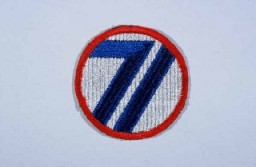
-
Insignia of the 12th Armored Division
PhotoInsignia of the 12th Armored Division. "Hellcats, " the winning entry in a division contest for a nickname held in early in 1943, symbolized the 12th's toughness and readiness for combat.
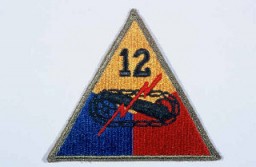
-
"What shall be done with the war criminals?"
ArtifactCover of booklet titled "What Shall Be Done with the War Criminals?" Published by the United States Armed Forces Institute, this was one of a series of 42 pamphlets created by the U.S. War Department under the series title "G.I. Roundtable." From 1943-1945, these pamphlets were created to "increase the effectiveness of the soldiers and officers and fighters during the war and as citizens after the war." Many of the pamphlets addressed the possibilities of a postwar world.
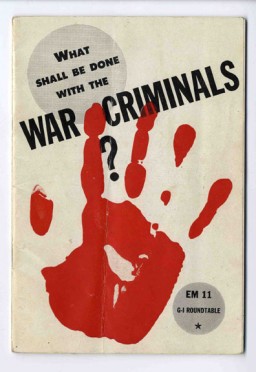
-
General Dwight D. Eisenhower views the Ohrdruf camp
PhotoGeneral Dwight D. Eisenhower (center), Supreme Allied Commander, views the corpses of inmates who died at the Ohrdruf camp. Ohrdruf, Germany, April 12, 1945.
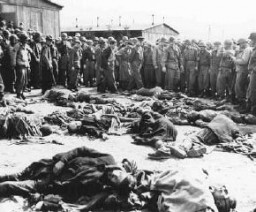
-
Insignia of the 1st Infantry Division
PhotoInsignia of the 1st Infantry Division. The 1st Infantry Division's nickname, the "Big Red One," originated from the division's insignia, a large red number "1" on a khaki field. This nickname was adopted during World War I, when the 1st was the first American division to arrive in France.
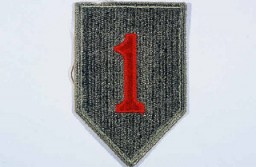
-
Insignia of the 14th Armored Division
PhotoInsignia of the 14th Armored Division. Although lacking a nickname during the war, the 14th became known as the "Liberators" soon afterward to signify its accomplishments in liberating hundreds of thousands of forced and slave laborers, concentration camp prisoners, and Allied prisoners of war in 1945.
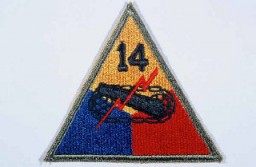
-
Insignia of the 84th Infantry Division
PhotoInsignia of the 84th Infantry Division. The 84th Infantry Division derives its nickname, "Railsplitter" division, from the divisional insignia, an ax splitting a rail. This design was created during World War I, when the division was known as the "Lincoln" division to represent the states that supplied soldiers for the division: Illinois, Indiana, and Kentucky. All figured prominently in the life of President Abraham Lincoln, of log-splitting legend.

